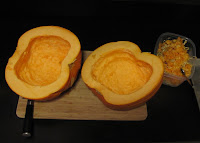
I have a few pumpkins leftover from an event at work last month. My plan was to compost them but that is going to take a while and these pumpkins are taking up too much space. I thought maybe I could use one to actually eat. Maybe in a pie.
Doing a lot of reading (here's an interesting page) about whether or not you can use a carving pumpkin instead of a sugar pumpkin (which is clearly what is considered best) for pie, I finally figured I'd never know for certain unless I just went ahead and did it.
Following these instructions found in the pie recipe I'd settled on, I proceeded to roast and puree a pumpkin:
Cut pumpkin in half and remove seeds. Place cut side down on a cookie sheet lined with lightly oiled aluminum foil. Bake at 325°F for 30 to 40 minutes, or until the flesh is tender when poked with a fork. Cool until just warm. Scrape the pumpkin flesh from the peel. Either mash or puree in small batches in a blender.
Preheat the oven to 325°F.
Wash the pumpkin and halve it.


I wish I could tell you how much this pumpkin weighed. Guessing, it was about 10 lbs.
Scrape out the seeds and stringy goop.


I didn't expect to find that seeds had germinated IN the pumpkin.
Lightly oil a baking sheet.

And place the pumpkin halves cut-side down on the baking sheet, trimming to fit as necessary.

Roast the pumpkin until the majority of the skin blisters and the flesh is fork-tender.



After one hour and 50 minutes, the pumpkin was starting to brown and the skin blister. I put it back in the oven for another 25 minutes even though it was fork tender. The pumpkin skin was certainly blistered on one half and it was starting to smell a little not-good.
Peel skin from flesh with a knife or spoon.

I started by peeling the blister away, which was easy. Then I found that the rest of the skin was still tightly bound to the flesh.
Return pumpkin to oven if the skin isn't easily removed.

Baked an additional 50 minutes.
And then I got tired. The pumpkin was placed back in the oven which was then shut off.
Twelve hours later, I took the pumpkin out of the oven and picked off the blister and most of the skin from the second half.

Seeing that a lot of the skin was still essentially welded to the flesh of the first pumpkin half, I cranked the oven back up to 325°F and baked the both pumpkin halves another 70 minutes.


While the pumpkin with skin was left to cool on the baking sheet, the remaining bits of skin was removed from the second half with a knife before it was sliced into sections.

In batches, chunks of the sliced pumpkin was ground, blended, and pureed in the blender.



When finished pureeing the first half, the skin of the second half was cut off with a knife before pureeing.

Yield: approximately 12 cups.
Well, that was interesting. I don't think it was necessary to continue baking the pumpkin in attempts to get the skin to come off easily. Unless you turn it into charcoal with really high heat or super long cooking time, overcooking a pumpkin destined for puree is probably impossible. The downside is that the skin doesn't smell good once it starts to char. At all. While the goal was to easily scrape the flesh from the skin, or the skin from the flesh, I found it was easiest just to use a steak knife and cut the skin away. If I do this again, I'll use a higher heat, say 350°F.
Pureeing the cooked flesh in the blender was the biggest hassle. I really should've cut the pumpkin into much smaller pieces since I had to really force the pumpkin down into the blender in order for the blades to do their thing. And then the blender didn't want to puree at first, so I just tried any high-speed option just to get it going. Once the pumpkin was broken down a little bit, I was able to switch gears and get a finer grind/blend and finally a puree. You could add water to help it along but I didn't want to make the puree any soupier than it had to be.
Silly me, I didn't think the yield would be so great. Twelve cups of puree is a lot! We'll find out how well it works in pie and how well it freezes. If this works well, I might make a few pies. Otherwise it's all compost. Oh, and if you're wondering, the puree doesn't taste good. It's actually a little gross.
0 comments:
Post a Comment